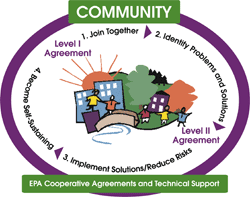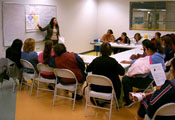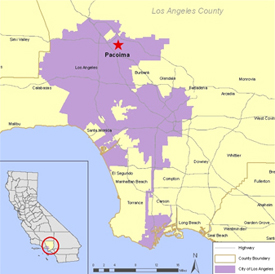Community Action for a Renewed Environment (CARE)
Reducing Toxic Risks In L.A. Community of Pacoima
Fall 2007

About CARE
Community Action for a Renewed Environment (CARE) is an EPA technical assistance and grant program that offers an innovative way for a community to organize and take action to reduce toxic pollution in the local environment.
Level I, Level II Grants
Awarded at two monetary levels, over two years, CARE grants help communities tackle their problems using a four-step process (see diagram below). Level I grants (up to $100,000) enable communities to progress through the first two steps, which are: 1) build a broad-based partnership and 2) identify a range of environmental problems and solutions. Level II grants (up to $300,000) fund the next two steps, which are: 3) take action to reduce risks and 4) become self-sustaining.
Pacoima, located in the northeast portion of California’s San Fernando Valley, is a Los Angeles community with an 83 percent Hispanic population. Pacoima residents are impacted by pollution from both mobile and stationary sources. The community is surrounded by three freeways, bisected by a railroad line, and is home to a small plane airport and more than 300 industrial facilities. Many residents either live across the street from or are adjacent to these potential sources of health risks.
Historically, many residents have been unaware of the potential health impacts of these facilities. However, a local group has been working to change that. Pacoima Beautiful (PB), founded in 1997 by five residents, is a bilingual, multi-cultural, community-based organization focused on neighborhood capacity building, environmental issues, and hazards affecting Pacoima. PB’s current CARE Level II project is a continuation of work initiated in 2005 under a Level I CARE grant to assess Pacoima’s environmental risks.

Step 1: Joining Together
As an integral part of the community, PB has built and nurtured collaborative partnerships and consensus-building relationships with residents and more than 150 organizations, agencies, and institutions inside and outside the community. These relationships serve as the basis for the CARE project’s stakeholder group. During 2006, under the CARE Level I grant, PB convened more than 320 community residents, partners, and stakeholders to review information on toxic sources in Pacoima.
Step 2: Identifying Problems, Solutions
As a result of the data gathering effort, PB and its partners first identified 18 categories of community health risks, and then ranked and prioritized them for action. PB found the Pacoima automobile sector to be a primary risk, as there are more than 100 auto body and auto repair shops in the community — many of which border a trailer park.
Step 3: Implementing Solutions, Reducing Risks
The CARE Level II grant, awarded in October 2007, will help PB partners take action to reduce risks from two of the identified community priorities: automotive shops in a targeted area of Pacoima and diesel emissions from trucks and buses throughout the community.

Pacoima promotoras (community health/environmental educators) train to identify health, flammability, and reactivity hazards of chemicals.
To reduce the health impacts from the automotive shops, PB will collect baseline data consisting of the number of regulated (permitted) and unregulated businesses using toxic materials. These businesses will be the focus of educational campaigns about the environmental, economic, and safety benefits of implementing environmental best management practices (BMPs). Indicators of success will include an increase in the: 1) number of facilities that install pollution prevention devices, 2) number of companies that document implementation of BMPs, 3) number of permits issued to businesses that require permits, and 4) number of enforcement actions taken by any regulatory agency against noncompliant companies.
To reduce the health impact from diesel trucks and school buses in residential neighborhoods, trained residents will collect baseline data by counting trucks and buses and documenting patterns of truck and bus traffic in residential areas. The success of this initiative will be measured by a reduction in the: 1) number of truck and bus traffic hours in selected high-risk areas, 2) number of residents exposed to documented reduced truck or bus traffic, 3) number of idling buses at or near schools, and 4) an increase in the number of diesel school buses and city buses that are replaced or retrofitted with new emission control technology.

Pacomia, CA
PB anticipates seeing significant environmental health improvements as a result of reduced emissions, reduced use of natural resources, and increased use of sustainable products. PB plans to achieve these environmental and health improvements through its implementation of environmental BMPs, as well as advanced community capacity through additional education about toxics and mitigation.
Step 4: Becoming Self-Sustaining
PB has received additional funding from the following sources to support the goals of the project and to become self-sustaining: the Liberty Hill Foundation and James Irvine Foundation; the California Endowment; the James and Flora Hewlett Foundation; and the Los Angeles Environmental Affairs Department. PB will make additional requests for funding to past supporters, such as the Wells Fargo Foundation, California State Department of Transportation, the Carl Moyer Program, and the United Way.
Partners
- California Air Resources Board
- California Department of Toxic Substances Control
- California Environmental Rights Alliance
- California State University Northridge
- Carl Maida, University of California–Los Angeles
- Initiating Change in Our Neighborhoods
- L. Fidell, Statistician
- Law firm of Arnold and Porter
- Los Angeles County Department of Health Services
- Los Angeles Environmental Affairs Department
- Luna, business owner
- Neighborhood Legal Services of Los Angeles County
- Northeast Valley Health Corporation
- Pacoima Beautiful
- Regional Water Quality Board
- South Coast Air Quality Management District
- State and Local Elected Officials
- Valley Care Community Consortium
- Valley Economic Development Center
- Many others
For Further Information
Please visit the CARE Web site for more information.
Karen Henry, Region 9 Project Lead
US EPA, Region 9
(415) 972-3844
henry.karen@epa.gov
Nury Martinez, CARE Project Lead
Pacoima Beautiful
(818)899-2454
nmartinez@pacoimabeautiful.org
wwww.pacoimabeautiful.org
